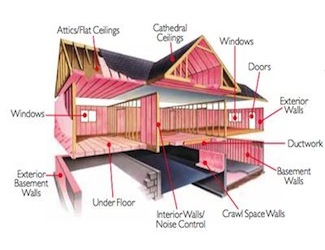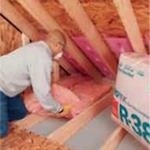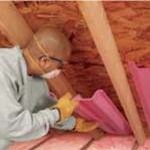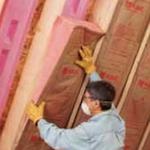Batt Insulation

Batt Insulation Methods
If the first thing that pops into your head when you think of insulation is a roll of pink fiberglass insulation being rolled into place by the Pink Panther, you're not alone.
Fiberglass insulation is the most widely used type of insulation in residential homes by far.
Fiberglass insulation is made primarily from silica (sand) spun into glass fibers. Most fiberglass insulation today also contains at least 30% recycled glass content. It will typically have an R-Value between 3.0 and 4.0 per inch.
Types of Fiberglass Insulation Installation Methods:
As with other types of insulation, fiberglass insulation comes in different forms. Which one you use depends on where you are having it installed. Any insulation must be installed properly, with the right thickness and no gapping, to be completely effective.

Fiberglass Batts
Batt Fiberglass Insulation
Batt (short for batting) fiberglass insulation comes in plastic-wrapped bales. The spun fabric creates a fibrous blanket which is simply unrolled into place one by one until the space is completely covered.
Batt fiberglass insulation is used mainly in unfinished walls, floors, and unenclosed attic spaces. Fiberglass batt insulation is well-suited for do-it-yourselfers, and for standard stud and joist spacing which is relatively free from obstructions.

Installing Insulation Dams
Loose Fill (Blown-In) Fiberglass Insulation
This type of fiberglass insulation is blown into place or spray-applied using special equipment, and is usually done by a professional. Loose fill fiberglass insulation is used in enclosed, existing wall cavities or open new wall cavities.
It is also used in unfinished attic floors and other hard to reach places. It is ideal for retrofitting existing areas or irregularly shaped areas with obstructions.
Whichever type of fiberglass insulation you choose, care should be taken during installation. Fiberglass fibers can be an irritant to the skin when touched, or to the lungs if inhaled, so the use of masks, gloves, and other protective gear when working with fiberglass insulation is a must.

Installing Blankets
Green Qualifications of Fiberglass Insulation
In addition to its excellent energy-saving qualities and wide availability, what else would make fiberglass insulation a good choice for a green home?
In the past, most fiberglass insulation was manufactured with a phenol-formaldehyde binder. The off-gassing of this formaldehyde can be a moderate indoor air quality concern. Fortunately, there are many companies today offering formaldehyde-free fiberglass insulation products. Due to formaldehyde's carcinogenic qualities, the use of a formaldehyde-free insulation is highly recommended.
The raw materials of fiberglass insulation are all naturally sourced. Silica, boron, and limestone are the most typically used materials in fiberglass insulation. As mentioned earlier, most fiberglass insulation today also contains anywhere from 30% to 65% recycled glass, much of it from recycled glass bottles. The use of recycled materials is less energy-intensive, reduces resource depletion, and keeps waste out of landfills.
Interested in installing your own Batt Insulation? Click here for a free PDF Installation Guide.
comments powered by Disqus

























































































































































































